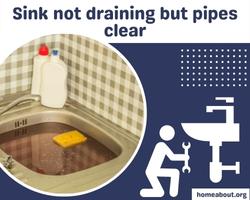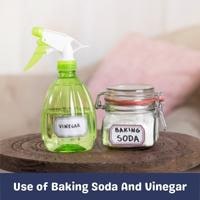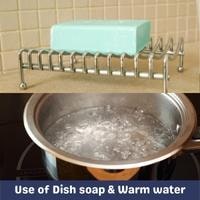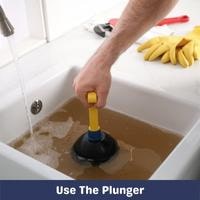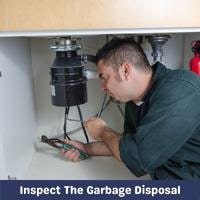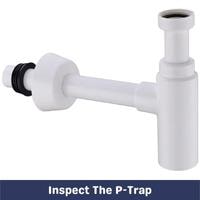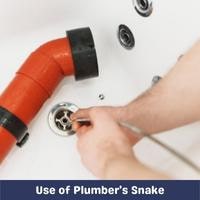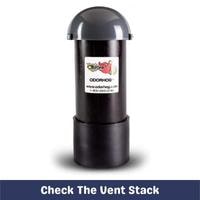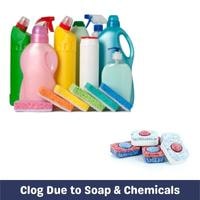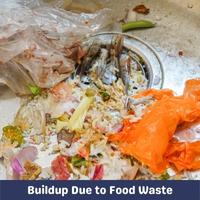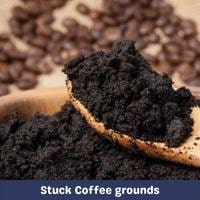Sink not draining but pipes clear. If you are experiencing a nightmare of the Kitchen sink draining issue, and you don’t even know what the problem is because you have checked the pipes, and they have no blockage or clogged.
Suppose you are washing the dishes regularly as you do, and suddenly you suspect that the sink is draining slowly, and with time, it stops draining.
It will be an irritating situation and a waste of time with the new issue, especially if you don’t have the time and don’t know the reason as well as the solution.
If you have already checked the pipes, but they are clear, and also flicking on the garbage disposal, but it does not work so, what will you do next?
Don’t tense yourself and take a deep breath because we are here to make your life easier while sharing our instructions and tactics to resolve your issue. Let’s start the troubleshooting without wasting any time.
Sink not draining but pipes clear
Clogging any machine is normal nowadays, and it can be fixed if you know the accurate instructions and the method of resolving the issue.
In this segment, we will share the reasons for the disturbing performance of the bathroom sink and kitchen sink drain and different ways of solutions to fix your problem.
Solutions To Fix Kitchen Sink Drain
This part will share accurate tips and tricks to fix the kitchen sink drainage issue. It does not require a lot of expensive tools, so you can feel easy while fixing the issue.
After following the guideline, you can follow some solutions to unclog the sink while using household items. Let’s get started without wasting your time
Use of Baking Soda And Vinegar
Before examining the components, you must follow some techniques for using effective non-abrasive ingredients. It will help you to resolve if there is an issue of draining slowly.
So, to proceed with the step, you require white vinegar and baking soda with boiling water that will effectively unclog a kitchen sink drain and help break the clog of a bathroom sink.
Before pouring vinegar and baking soda, remove the dishes from the kitchen sink. You must use a suitable thing to remove the standing water from the sink.
Enable the hot tap water and let the hot water flows in the kitchen sink drain for almost 25 to 35 seconds. Leave it for some time so the hot water can loosen the buildup.
Now, get ready with the baking soda and vinegar. Firstly, you must put one cup of baking soda into the sink drain.
If you want that your vinegar and baking soda to work as chemical drain cleaners, then you must pour the vinegar into the drain. But don’t put all the vinegar at once.
You have to give time to baking soda and vinegar for a reaction to drain clogs, so leave it for almost 20 to 25 minutes.
In the end, you must pour boiling water into the kitchen sink drain opening and build pressure to avoid the clog. You may also use the method to unclog the bathroom sink.
Use of Dish soap & Warm water
Another method that can efficiently work for declogging food waste buildup due to coffee grounds or fats, oil, or grease, may resolve it using a solution of dish soap and hot water in the kitchen sink.
So, to do this method, firstly, ensure that your kitchen sink is empty so you can easily proceed with the procedure.
Take half a cup of dish soap, put it into the sink drain opening, and then close it with a sink stopper. Wait for 15 minutes.
Now, you require boiling water for rinsing into the sink after removing the standing water.
This time ensure that you pour all the hot water at once to create water pressure, which will help the unclogging kitchen sink with that pressure force.
In the end, you must check the water drains and whether it starts draining properly or not. You may repeat the process to get smooth water draining.
Use The Plunger
Another helpful tool that you can use for breaking any blockage is a plunger. It is a widespread tool that almost every house contains, and most of you already know the use for it
But if you are unaware of it when we are here to explain you. Firstly if you don’t have the tool, it would be best to purchase a flat-bottom plunger.
Don’t worry. It’s not expensive, as you can cheaply fix the issue even after purchasing the tool.
It would be helpful if you have a plunger that owns a flat suction cup or flat shape. But if you already contain a plunger, you can use it on the spot.
But one thing that we want you to remember is that you can’t use the plunger that you used in your bathroom; that must be bell-shaped and unsuitable. Ensure that you have a sink plunger.
Before using the plunger, pour hot water into the sink. You have to fill it until it gets to its half level.
Place the plunger on the drain and start pumping to create pressure. In the beginning, you must push the plunger slowly so the water won’t splash on you.
When you suspect that it starts working, then you can plunge fastly. Keeps plunging till the water starts running smoothly in your kitchen sink. If it doesn’t work, you may proceed to the following procedure.
Inspect The Garbage Disposal
You must check the garbage disposal for any blockage or clog if you are experiencing slow draining or stop draining your kitchen sink. Sometimes it gets clogged when you throw the appropriate things into your sink.
You may use another trick to check whether your garbage disposal is the culprit or not. You can go through this trick if you have a double sink.
If one of your sinks attached to the garbage disposal is blocked and another is working, it means you have an issue with the disposal.
At first, you must flick on the disposal. Ensure that you have enabled the garbage disposal with a hot water supply.
After turning on the hot water, you may suspect that the disposal of the Kitchen sink is making an unfamiliar sound, indicating that your garbage disposal is clogged.
Don’t worry. You can fix it by following our instructions, so firstly, you must disconnect the power cord from the circuit board. Don’t ever try to put your hand into the disposal for any inspection. You must follow the steps to avoid any danger.
You can use an Allen wrench or a wooden stick for rotating or spinning the garbage disposal blades after inserting one of the tools from a hole in the base of the disposal. It will effectively help to unclog a garbage disposal.
It will help if you spin until you don’t suspect that it’s unclogging now. It’s a beneficial method for cleaning the sink’s disposal.
You must test whether the draining is working or not. If it doesn’t work after breaking the clog, proceed to the next step.
Inspect The P-Trap
P-Trap is a U-shaped pipe that is located beneath the kitchen sink. If your sink is not draining, there might be an issue with the P trap of your sink.
It may get blocked with food particles or debris, so in this situation, you may experience the issue of not draining properly or draining slowly.
If you have tried the previous method and it doesn’t work, you must inspect the drain trap. For troubleshooting, you must detach the elbow-shaped pipe from its spot to remove the blockage.
It might be possible that this method of solution results in splashing water or creating a mess. So, it would be better to mentally and physically prepare yourself first.
Before starting the procedure, wear your safety costumes, like plastic gloves or safety goggles. While detaching the drain trap’s connectors, you must keep a dustbin aura bucket under the pipe.
It will save you from splashing water and blockage material on the floor. While inspecting the pipe, you may come to know that it contains two connectors. Both contain different height levels, so you must start using a wrench from the bottom.
You must be careful while removing the screws to prevent any damage to the plastic pipes. Remove the pipe after getting all the water from the pipe into the bucket. Now, you must clean the blockage from the pipe.
You may follow the same procedure to attach the P-trap to its correct position. Allow the hot water supply to run through the pipe so that you can inspect the sink drain performance and check any leakage from the P-trap.
Sink won’t drain after cleaning p trap
Use of Plumber’s Snake
While resolving your issue about the Kitchen sink won’t drain, here we are using another handy item which is a plumber snake.
It contains a coiled spiral snake that can easily access the clogged drain. You may insert the drain snake into the drain opening.
Let the snake goes into it until you don’t inspect any interference.
Use a little force and start rotating the plumber snake. There are two types of plumber’s snake: one that you can use manually to break the clogged and does not use electricity.
The other uses electricity that can unclog the sink drainage even more efficiently. If you do not own a plumber snake or don’t want to purchase it, we have another trick for you.
So, we have an alternate tool that you can use for breaking the clog, a wire coat hanger. It would help if you detangled it by using a set of needle nose pliers.
It is also very effective when converting into a straight metal wire. After detangling, making a hook at one end of the wire would be better. It will help you to take out the clogged material.
Insert the second straight end into the drain from the drain opening. Let the wire goes into the pipe until you don’t suspect any interference on the way.
Carefully spin the metal, but don’t rub it harshly or forcefully because it can damage or wear out the pipes. When you suspect that you have broken out the clog, rinse the hot water and see whether the water drains appropriately or not.
Check The Vent Stack
Another Component that requires your attention while fixing the draining issues is the vent stack. It might be a culprit of a slow drain or clogged sink.
It’s a vertical pipe that comes out from the roof of your house and drives with the drain pipe.
Mostly it is used for ventilation in the drain pipes and gets off the sewer gases. When the vent becomes clogged, it disables the air circulation and gets stuck into the pipes.
To resolve this issue, you require a garbage hose, and then you must get on your house roof. You must inspect the other debris or any blockage; if you find anything unnecessary, you must remove it.
Things that Must Go to Trash
When Kitchen sinks drain slowly or won’t drain properly, there must be some reasons behind the scenes you don’t know.
Here is a list that could be a few reasons for the draining issue, or you may see it as instructions that do not allow these things goes through your sink. It will help you to avoid future complexities. How to fix a clogged bathroom sink
Clog Due to Soap & Chemicals
The first reason that is possible for slow training or stop training is soapsuds or build up because of chemicals.
While washing dishes, when the dishwashing soap gets together with minerals, it can generate or develop soap scum.
Maybe you have seen it before; it looks like a white substance that firmly sticks to the moisture area that uses soap and chemicals, including bathroom sinks, tubs, or kitchen sinks.
You can blame it for the blockage when it grows with time. It is the same as when you use chemicals, specially Harsh or abrasive, which may cause blockage and create the stop-draining issue.
Buildup Due to Food Waste
Another reason for not draining water is food waste that gets into the sink drain while washing dishes.
Some leftovers of salad, pasta, or other food items could be blamed for the draining issue.
It doesn’t matter if your sink contains garbage disposal; food debris is actual for clogged drain issues.
So, it would be better to remove the waste food from the dishes first and throw it in the dustbin. After that, you can start washing to prevent future clogs due to these food particles.
Clogging Due to Veggies Peels or Stickers
Another thing that doesn’t dissolve easily is stickers from your veggies. Whenever you get veggies or fruits from the market, they have some tags or stickers.
While washing, they could get into the garbage disposal, and the drain gets affected. Another thing is fruits, or veggies peels get into the drain opening. But you don’t know it’s not easy for them to dissolve quickly.
Water coming back up kitchen sink
Later, it becomes the reason for your sink drain’s inappropriate performance. Ensure you have removed the stickers and peels before they go to the drain.
Stuck Coffee grounds
Another reason that you must be concerned is don’t throw the coffee grounds into the kitchen sink drain. It might not be clogged drains at once, but it gets drains slowly with time.
In the end, you faced entire clogged sink drains. And these kinds of blockages never get unclogged without rinsing the hot water with a dissolving solution.
Fats/ Grease Blockage
Another damaging item that might be a culprit for slowly draining or not draining is fats and grease buildup in the sink.
It would be best if you noticed that after finishing the meal, the oil gets thick even at a normal temperature. What about when you wash it in the sink drain?
Starchy foods, oil, grease, or fat are harmful to the sink draining as they start building up in the drain pipe and end up with clogged drains.
Final Thoughts
This article explained the troubleshooting ways when your kitchen sink or bathroom sink stops draining.
Moreover, this article will educate you that what things you must avoid from going to the disposal or sink. That may result in clogging issues.
These accurate instructions will able you to inspect different factors, including an air vent, clogged P-trap, way to use a plumber’s snake or plunger, etc.
These guidelines must able you to get back the efficient working of your sink draining using different non-toxic ways. Kitchen sink gurgles when toilet is flushed
